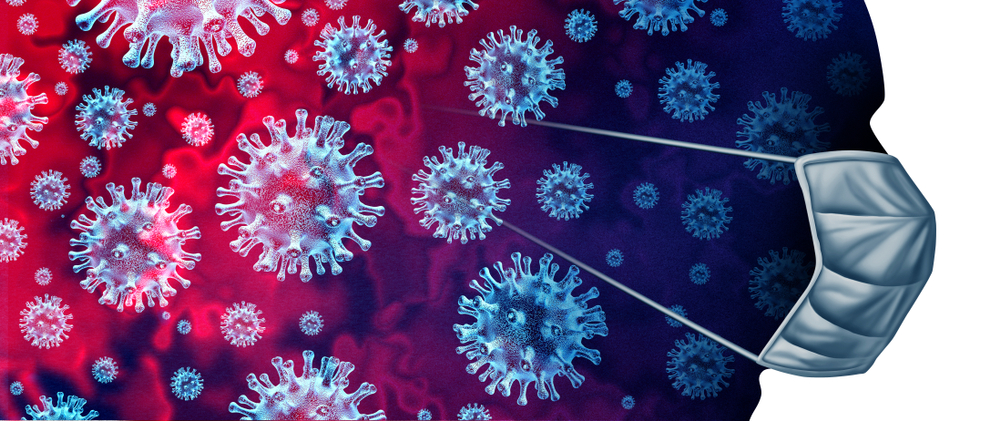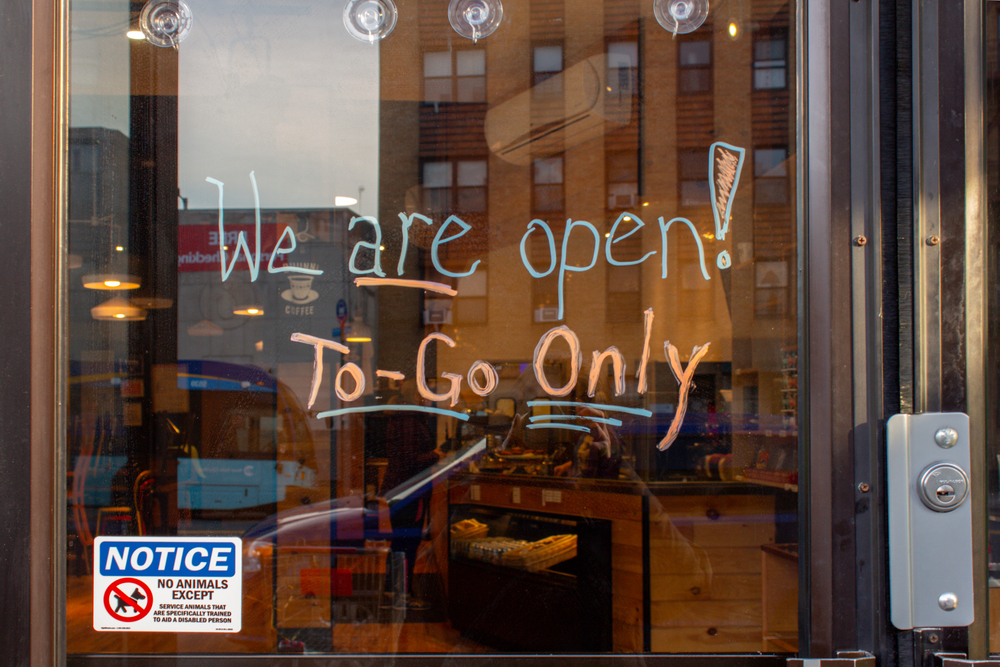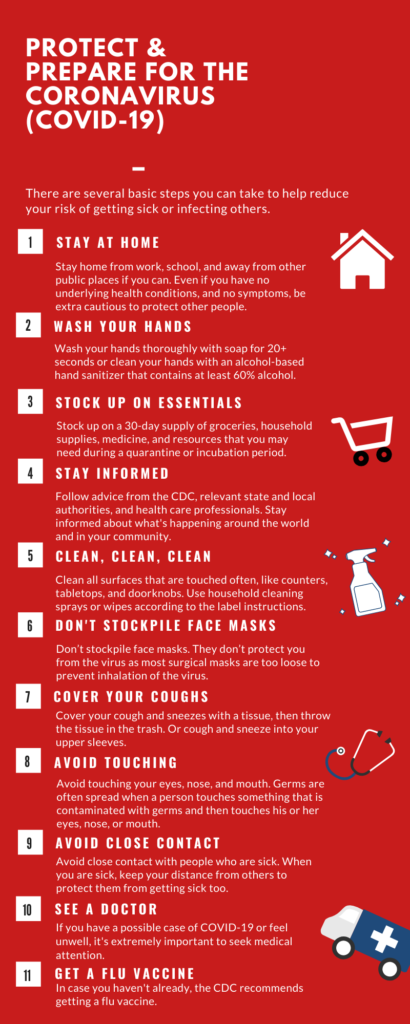
The start of 2020 not only brought a new year, but it also brought a new decade. The saying, ‘new year, new me’ is often used when people are preparing their new year’s resolutions lists – things they want to accomplish within the next 365 days. Oftentimes, people and businesses will set goals for themselves that they hope to achieve by the same time the following year. One thing no business expected or planned with the start of the new decade was to be hit with a mysterious pneumonia-like virus outbreak known as the novel Coronavirus (COVID-19).
COVID-19 is Declared a Worldwide Pandemic
The amount of cases due to Coronavirus (COVID-19) in the United States and around the world continues to increase daily. As a result, the World Health Organization has declared the novel COVID-19 a worldwide pandemic. As of Thursday, March 26th, 2020, 1:13 P.M. E.T., the coronavirus pandemic has sickened more than 489,500 people, according to official counts. The New York Times reports that at least 21,975 people have died, more than half of which were outside of mainland China. There is also evidence that the virus has reached six continents. The Centers for Disease Control and Prevention (CDC) has advised against all non-essential travel throughout most of Europe, and to South Korea, China, and Iran. Moreover, the CDC has warned older and at-risk Americans to avoid travel to any country out of the United States.
The New York Times has created a Coronavirus map to track the global outbreak, which can be seen here. As the map below shows, more than 171 countries have reported cases of infected people.

Coronavirus in the United States
The number of known coronavirus cases in the United States continues to grow quickly as well. As of Thursday, March 26th, 2020, 1:13 P.M. E.T., the number of known cases of the coronavirus in the United States exceeded 75,000 cases of coronavirus confirmed by lab tests as testing expanded and the virus spread. There are at least 75,178 people across all 50 states, plus Washington D.C., and three U.S. territories, that have tested positive for coronavirus, according to the New York Times database. In addition, at least 1,069 patients with the virus have died. The New York Times has created a Coronavirus map to track the reported cases in the United States, which can be seen here.

Coronavirus and its Impact on Businesses
Businesses During the Coronavirus (COVID-19) Pandemic
More state and private labs in the United States have begun running tests for the coronavirus (COVID-19) in recent days, which has increased the capacity to identify new patients. In previous weeks, there have been weeks of delays and test kit shortages. As the United States scrambles to understand the extent of an escalating public health crisis, life in many states has become standstill. With people told to social distance to help ease the pandemic and contain the outbreak, governors have ordered schools and businesses to close. Gatherings, meetings, concerts, festivals, and sporting events have been canceled. Amusement parks, movie theaters, bars, clubs, and restaurants have closed. Gyms in several states are being ordered to close as officials have decided that rooms full of people working out and breathing hard is too risky. Grocery stores and other retailers that sell food or basic supplies are staying open with limited hours to allow for cleaning and restocking of store shelves. The fast-spreading virus has put a halt on daily activities like date nights and eating out. Essentially all activities that involve crowds have been paused. In some places, residents have even been ordered to stay inside.
In addition to the illnesses and deaths associated with the COVID-19, the novel Coronavirus has begun impacting daily life as well as businesses across a multitude of industries. Large businesses like Apple, Nike, Patagonia, and thousands of others have started shutting down in the nation’s largest cities — New York, Chicago, Los Angeles, and San Francisco. Moreover, many smaller businesses around the nation have also shut down.
“We will be closing all of our retail stores outside of Greater China until March 27,” Apple’s CEO Tim Cook said in a statement. Stores in China are reopening as that country says it has contained the outbreak. “One of those lessons is that the most effective way to minimize risk of the virus’s transmission is to reduce density and maximize social distance,” he said.
America’s economy has begun to shut down as pandemic measures take hold. With this halt, also comes a halt to economic activity. In California, for instance, the state has begun enacting extreme measures to prevent the virus from spreading even more. A shelter-at-home order has been put in place in which residents were told not to go out for three weeks except to meet “essential needs.”
Despite the White House advising all Americans to practice social distancing, the number of coronavirus cases in the US continues to rise. So governors across the nation are taking stronger action by issuing stay-at-home orders in their states. By Wednesday, March 25th, when all 12 current state orders take effect, 126,800,466 people, or 39% of the US population, will be officially urged to stay home. The following states have implemented stay-at-home orders: California, Connecticut, Delaware, Illinois, Indiana, Louisiana, Massachusetts, Michigan, New Jersey, New York, Ohio, and West Virginia. Under these orders, comes various rules with what residents can and cannot do. Taking a walk, riding a bike and being out in nature for exercise is allowed, however, but people should stay at least 6 feet away from others. Moreover, all nonessential businesses are to close and restaurants are only to offer take-out, delivery or drive-thru. With people being told to social distance themselves to help ease the coronavirus (COVID-19) pandemic, businesses across the nation have been forced to rapidly adapt their business models and marketing. So it leaves the question, what can a business do to adapt and market themselves during the outbreak of the novel Coronavirus (COVID-19)?

How Businesses Should Plan for and Respond to the COVID-19 Virus
The CDC has advice on how businesses can plan for and respond to the COVID-19 outbreak. The following recommended strategies are for employers to use now:
- Actively encourage sick employees to stay home: If your business is still open, it’s extremely important that employees who have symptoms of acute respiratory illness are recommended to stay home and not come to work until they are free of fever (100.4° F or greater using an oral thermometer), signs of a fever, and any other symptoms for at least 24 hours, without the use of fever-reducing or other symptom-altering medicines (e.g. cough suppressants). Employees should notify their supervisor and stay home if they are sick.
- Ensure that your sick leave policies are flexible and consistent with public health guidance and that employees are aware of these policies.
- Talk with companies that provide your business with a contract or temporary employees about the importance of sick employees staying home and encourage them to develop non-punitive leave policies.
- Don’t require a healthcare provider’s note for employees who are sick with acute respiratory illness to validate their illness or to return to work, as healthcare provider offices and medical facilities may be extremely busy and not able to provide such documentation in a timely way.
- Employers should maintain flexible policies that permit employees to stay home to care for a sick family member. Employers should be aware that more employees may need to stay at home to care for sick children or other sick family members than is usual.

Creating an Infectious Disease Outbreak Response Plan
The CDC also recommends that all employers should be ready to implement strategies to protect their workforce from COVID-19 while ensuring continuity of operations. During a COVID-19 outbreak, all sick employees should stay home and away from the workplace, respiratory etiquette and hand hygiene should be encouraged, and routine cleaning of commonly touched surfaces should be performed regularly. Employers should:
- Ensure the infectious disease outbreak response plan is flexible. It would also be a smart idea to involve your employees in developing and reviewing your plan.
- Conduct a focused discussion or exercise using your plan, to find out ahead of time whether the plan has gaps or problems that need to be corrected.
- Share your plan with employees and explain what human resources policies, workplace and leave flexibilities, and pay and benefits will be available to them.
- Share best practices with other businesses in your communities (especially those in your supply chain), chambers of commerce, and associations to improve community response efforts.
- Identify possible work-related exposure and health risks to your employees.
- Identify essential business functions, essential jobs or roles, and critical elements within your supply chains (e.g., raw materials, suppliers, subcontractor services/products, and logistics) required to maintain business operations. Plan for how your business will operate if there is increasing absenteeism or these supply chains are interrupted.
For more recommendations in planning, preparing, and responding to the Coronavirus as an employer, be sure to check out the CDC’s strategies and guidelines here.
A Survival Guide for Responding to the Coronavirus (COVID-19) Outbreak
We’ve designed a survival guide to help you prepare and respond to any impact the COVID-19 outbreak will have on you and your business.
- Communicate Early
- If you hold contracts that could be impacted by the coronavirus outbreak — in terms of performance, schedule, or cost — be sure to reach out to those involved earlier than later.
- Explore mutually acceptable ways to handle issues relating to the virus (i.e. employees are unable to report to work, there’s a shortage of staff, there’s a delay in performance, etc.)
- Be sure to make any changes to your agreements in writing to help protect against any future claims that may arise.
- Review your contract’s delay clauses
- There are more than likely a number of various delay clauses that could be in your contracts, which would have been tailored to the specific contract type. The clauses provide specific procedures for handling delays beyond the control of the contractor. You should review your contracts to see what delay clause(s) you have. More than likely, you’ll encounter delays during the virus, so it’s important to ensure you’re following the applicable procedures.
- Document everything
- You should document any increased costs or delays attributed to the virus, and more generally, document how the virus impacts your performance for your fleet. There are cases where a contractor was unable to recover for a delay due to a “flu epidemic” because it didn’t adequately document the impact of the delay. It’s better to document everything to help your future self.
- Consider trying to recover or offset your increased costs
- If you experience increased costs on your ongoing contracts, consider requesting a contract modification to cover those costs. If you are a commercial items contractor selling at fixed prices or rates, consider requesting an Economic Price Adjustment under your contract’s EPA clause. The standard EPA clause gives a contracting officer discretion to approve unscheduled increases due to surprising national/international events.
- Review your sick-leave policy
- Many contractors, like many companies, give their employees only limited sick leave. At the same time, having employees attend work because they are out of sick-leave creates significant risk. Contractors should consider how they plan to handle sick employees who are unwilling to stay home (or employees who need to stay home to care for a loved one). While standing outside the factory door with a thermometer may not be the answer, neither is ignoring the reality of the problem. Contractors will be well served by putting together a working group that involves HR and Legal – and probably your employment law counsel and privacy counsel – to implement a practical plan of action.
How to Recognize the Symptoms of the Coronavirus (COVID-19)
Reported illnesses have ranged from mild symptoms to severe illness and death for confirmed coronavirus disease 2019 (COVID-19) cases. The following symptoms may appear within 2-14 days after exposure:
- Fever
- Cough or sore throat
- Difficulty breaking or shortness of breath
- Nausea
- Phlegm
- Diarrhea
- Bluish lips or face
- Persistent pain or pressure in the chest
- Dizziness
- Runny nose
- Pneumonia
How to Protect Yourself and Prepare for the Coronavirus
Older Americans, those with underlying health conditions, and those without a social safety net are the most vulnerable to the infection and its societal disruption. Although there are still many unknowns with this virus, there are still several basic steps you can take to help reduce your risk of getting sick or infecting others:
- Stay home from work, school, and away from other public places if you can. Even if you have no underlying health conditions, and no symptoms, be extra cautious to protect other people. Not everyone who carries the virus will necessarily see symptoms. If you must go out, avoid using any kind of public transportation, ridesharing, or taxis.
- Wash your hands. With soap. Then wash them again. As a rule of thumb, many people have agreed that you should wash your hands thoroughly for at least 20 seconds or clean your hands with an alcohol-based hand sanitizer that contains at least 60% alcohol. Singing the “Happy Birthday” song twice is a great point of reference.
- Stock up on essentials including groceries, medicine, and any other resources that you may need during a quarantine or incubation period. It’s recommended that you stock up on a 30-day supply of groceries, household supplies and prescriptions, just in case. For smart tips on stocking up your pantry, click here. If you take prescription medications or are low on any over-the-counter essentials, go to the pharmacy sooner rather than later. Moreover, make sure you’re set with soap, toiletries, laundry detergent, toilet paper, and diapers if you have small children.
- Stay informed. Information about how to stay cautious, what’s happening throughout the world, etc. is constantly being updated. To know how to protect yourself and others, it’s extremely important to know what’s happening. Americans should follow the advice from the CDC, relevant state and local authorities, and health care professionals.
- Clean all surfaces that are touched often, like counters, tabletops, and doorknobs. Use household cleaning sprays or wipes according to the label instructions.
- Don’t stockpile face masks. Face masks have become a symbol of coronavirus, but stockpiling them may actually do more harm than good. They don’t protect you from the virus as most surgical masks are too loose to prevent inhalation of the virus. Masks can help prevent the spread of the virus if you are infected, however. Moreover, health care workers and those caring for sick people on the front lines need these. Stockpiling masks could limit the number of available resources to doctors, nurses, surgeons, and emergency professionals.
- Cover your cough and sneezes with a tissue, then throw the tissue in the trash. Or cough and sneeze into your upper sleeves.
- Avoid touching your eyes, nose, and mouth. Germs are often spread when a person touches something that is contaminated with germs and then touches his or her eyes, nose, or mouth.
- Avoid close contact with people who are sick. When you are sick, keep your distance from others to protect them from getting sick too.
- See a doctor if you feel unwell. If you have a possible case of COVID-19 or feel unwell, it’s extremely important to seek medical attention.
- Get a flu vaccine, if you haven’t already.

Learn more about Vivid Candi, a digital tech agency in Malibu, that offers full-service digital marketing services, custom web design and development, and more for a multitude of clients.

